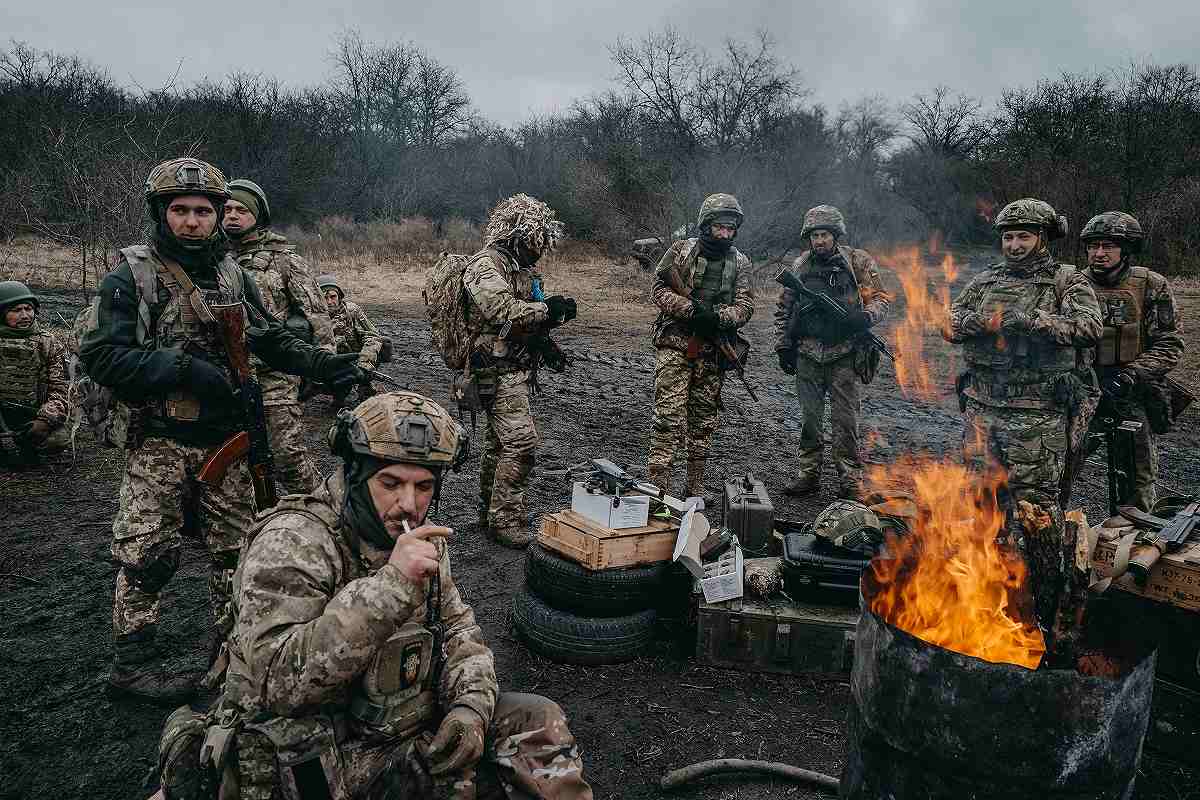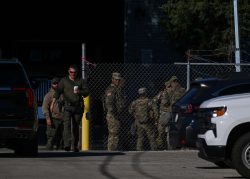
Ukrainian military recruits conduct training in February.
16:46 JST, March 16, 2024
U.S. officials foresee a range of bleak scenarios in Ukraine if the military aid President Biden has requested doesn’t materialize, including a catastrophic breakdown of Ukrainian lines in the grimmest contingency and the likelihood of massive casualties in the best.
Even as Biden piles pressure on Congress to approve his proposal for $60 billion in new aid, held up for months by Republican opposition, administration officials acknowledge they must also prepare for other outcomes.
“This doesn’t go well for Ukraine over time without a supplemental, and it could lead to potential collapse,” a senior U.S. official said. “But here’s the bottom line: Even if Ukraine holds on, what we really are saying is that we are going to leverage countless lives in order to do that.”
CIA Director William J. Burns, speaking to lawmakers this week, warned that absent U.S. aid, the territorial losses this year will be “significant” and that time is running short.
Hoping to maintain the public focus on Congress, administration officials have refused to openly address any alternate realities for Ukraine. But in private, they are fast coming to terms with the prospect that Washington’s political dysfunction may prevail, either by tanking the aid package or passing it too late to avoid disaster for the government in Kyiv.
Democratic and bipartisan groups of lawmakers in the GOP-controlled House this week launched separate attempts to circumvent the refusal of Speaker Mike Johnson (La.) to hold a vote on a huge national security package that passed the Senate last month with bipartisan support. It is far from certain, though, that they can overcome the partisan deadlock.
On Thursday, Johnson told Politico that he expects to pass a bill with additional military assistance for Ukraine by leveraging Democratic votes, an acknowledgment that he may not have enough support among Republicans to do so. Additional aid for Ukraine and Israel’s war in Gaza could be raised as one bill or two, he said.
The White House did not immediately comment on the administration’s outlook in case of a continued inability to secure new aid.
Ukrainian President Volodymyr Zelensky has warned that a dwindling supply of air defense missiles is making Russia’s regular air attacks more deadly. On the front lines, troops are rationing artillery shells.
The United States is, by far, Ukraine’s largest military backer, donating more than $40 billion in aid since the war began two years ago. While Europe is racing to ramp up defense production, it has provided only a third of the shells it promised for this year, Zelensky has said.
Russia, meanwhile, on top of its huge manpower advantage, is flooding Ukraine with drones and is on pace to manufacture 2.7 million shells, according to Olha Stefanishyna, Ukraine’s deputy prime minister for European and Euro-Atlantic integration, far outstripping near-term U.S. production. Speaking last week in Washington, she said that “every day of indecisiveness” in the West will result in greater loss of life and diminish her country’s military outlook.
“Ukraine’s resilience,” Stefanishyna added, “should not be taken for granted.”
Despite exceeding expectations in the initial months after Russia’s invasion, Ukrainian forces have struggled to shatter what has become a protracted stalemate – a fact often emphasized by opponents of Biden’s funding request. The Ukrainians failed to achieve their goal last year of threatening Russia’s land route to occupied Crimea, and last month saw significant Russian breakthroughs.
American officials, describing their assessments should U.S. funding for Kyiv be permanently severed, said where Ukraine would land within their range of scenarios would hinge on its ability to mobilize new forces, the success of Western training initiatives, and troops’ morale, among other variables. They spoke on the condition of anonymity to discuss what they characterized as a consensus within the Biden administration.
“Whether it ends in collapse or large casualties” remains a subject of internal debate, the senior official said. “But there is no future that is bright for Ukraine without a supplemental and continued U.S. support.”
– – –
Russia’s advantages
Officials noted with some optimism that Ukraine has the inherent advantage of fighting on defense and has done so with significant success. Its forces are working to establish hardened fortifications, including trenches and physical barriers, in a fashion similar to what the Russians did while Ukraine prepared last year’s counteroffensive. Their goal is to create three lines of defense in some areas, analysts say.
Russia, like Ukraine, has struggled to take new territory, and despite some recent gains, it is far from evident that its military has gotten any better on offense. The Kremlin has experienced consistent morale problems among its troops, many of whom are conscripts or poorly trained volunteers who now confront the challenge of attempting to push forward.
But even as Russia faces a huge web of Western sanctions, its president, Vladimir Putin, has been able to funnel resources toward the production of shells, tanks and other hardware. He has also tapped allies Iran and North Korea for aerial drones and other weapons supplies.
On Friday, the Biden administration accused Iran of preparing to expand its military cooperation with Russia by providing Moscow with advanced ballistic missiles to use in Ukraine. The United States and its Group of Seven partners issued a joint statement warning Tehran of swift consequences, including the possible prohibition of its state-owned airline from landing planes in Europe.
Samuel Charap, a scholar at the Rand Corp., noted that Ukraine had managed to repel Putin’s attempt to capture Kyiv and other major cities in the war’s initial weeks, despite having little of the sophisticated weaponry it later received from the West. “Ukraine was able to defend all these cities … without much of any Western assistance at all,” he said.
But Putin also retains a huge manpower advantage. Although the invading forces have taken staggering losses, Russia has the ability to dip into its much larger population for additional recruits. Ukraine’s battlefield losses in contrast – which the government recently said stood at about 30,000 killed in action – are felt more acutely given Kyiv’s comparatively smaller force size.
“Russia can lean and lean and lean and waste human resources at a shocking rate, and so it is difficult,” a second senior U.S. official said. “And so the question is, how do [Ukraine’s] forces stand up, and their morale, during this time?”
A senior adviser to Zelensky agreed there was a high likelihood of significant Russian territorial gains against Ukraine by the summer in the absence of new U.S. aid.
“People don’t understand how bad the front is right now,” the adviser said. “The morale is low; the momentum is low. Young men are afraid they will be mobilized to die because of a lack of weapons.”
A spokesman for Zelensky did not respond to a request for comment.
There is no immediate solution in sight to Kyiv’s intensifying manpower challenge. While the government had hoped to expand conscription, a proposal to do so remains stuck in Ukraine’s parliament, raising the possibility those forces won’t materialize this year.
Michael Kofman, a senior fellow at the Carnegie Endowment for International Peace, said the lack of adequate manpower, particularly infantry troops, and the need for stronger fortifications would be crucial in determining Ukraine’s trajectory.
“If the supplemental passes but Ukraine does not address its manpower issues, then it will certainly buy time, but the structural problem remains,” Kofman said.
Russian air attacks will also take an increasing toll. Ukrainian policymakers have told European and U.S. officials that munitions for some of their missile defense systems may be nearly used up by the end of March, according to two officials who met with the Ukrainians at a security conference last month.
While Ukraine has tried to shoot down 4 of every 5 missiles fired at its cities, it soon may be able to target only 1 in 5, one of those officials said. That would have a significant effect on life in Ukraine’s urban centers, many of which have assumed a relative normalcy over the last year as missile defense has generally proved effective.
Against that gloomy backdrop, the Biden administration is encouraging Kyiv to harden its defenses and to continue to pressure Russia’s military assets in Crimea and the Black Sea.
– – –
‘Exploit all margins’

Inside a Finnish production facility where 155mm artillery shells are made.
The increasingly alarming battlefield picture has prompted officials in Washington and across Europe to reconsider what risks they are willing to take to their own security to continue to assist Ukraine.
On Tuesday, for instance, the Pentagon announced that it would send $300 million in additional U.S. weapons to Kyiv after finding “unanticipated cost savings” in recent arms contracts. The package includes medium-range cluster rounds for the Army Tactical Missile System, or ATACMS, which has a range of about 100 miles. Ukrainian forces have used the system to target Russian headquarters and troop formations.
Washington is also exploring how the Pentagon might continue to provide donations and training if the supplemental funding remains stalled, a U.S. official said. That could include leveraging the administration’s authority to donate up to $4 billion in weapons from U.S. stockpiles, which officials have said they would not employ unless Congress approved funds to replenish those stores.
Those discussions mirror a process underway in Europe to reassess what its militaries can part with from their stockpiles and what they are willing to purchase for Ukraine.
European nations, for example, are abandoning their insistence that arms purchases be sourced in Europe, coming together behind a Czech initiative to procure ammunition from outside the continent. Denmark recently announced that it would give its entire stockpile of artillery to Ukraine. Britain has pledged 10,000 additional drones and is working to help Kyiv develop new drone capabilities.
“No matter the level of U.S. support that’s given, we’re not going to walk away,” a Western official said. “We might adapt our approach toward how we work best with them and think a bit more creatively.”
French President Emmanuel Macron, staking out an increasingly hawkish position for France, convened an emergency meeting on Ukraine last month and raised the possibility of sending personnel from NATO countries into Ukraine – potentially maintenance experts or trainers – to free up Ukrainian troops to fight.
A French official said that France, like other supporters of Ukraine, was looking at a range of possibilities to assist Kyiv and “exploit all margins” below the threshold of directly wading into the war. France has placed orders for new arms, including artillery shells, surface-to-air missiles and air defense systems to assist Ukraine in the near term.
France and other nations are going through a “risk-management process” as they seek to sustain their own security and stave off the worst for Ukraine. “This support cannot stop,” the official said, “because we all know we cannot afford to let Russia win.”
"News Services" POPULAR ARTICLE
-

American Playwright Jeremy O. Harris Arrested in Japan on Alleged Drug Smuggling
-

Japan’s Nikkei Stock Average as JGB Yields, Yen Rise on Rate-Hike Bets
-

Japan’s Nikkei Stock Average Licks Wounds after Selloff Sparked by BOJ Hike Bets (UPDATE 1)
-

Japan’s Nikkei Stock Average Buoyed by Stable Yen; SoftBank’s Slide Caps Gains (UPDATE 1)
-

Japanese Bond Yields Zoom, Stocks Slide as Rate Hike Looms
JN ACCESS RANKING
-

Tokyo Economic Security Forum to Hold Inaugural Meeting Amid Tense Global Environment
-

Keidanren Chairman Yoshinobu Tsutsui Visits Kashiwazaki-Kariwa Nuclear Power Plant; Inspects New Emergency Safety System
-

Imports of Rare Earths from China Facing Delays, May Be Caused by Deterioration of Japan-China Relations
-

University of Tokyo Professor Discusses Japanese Economic Security in Interview Ahead of Forum
-

Japan Pulls out of Vietnam Nuclear Project, Complicating Hanoi’s Power Plans
























